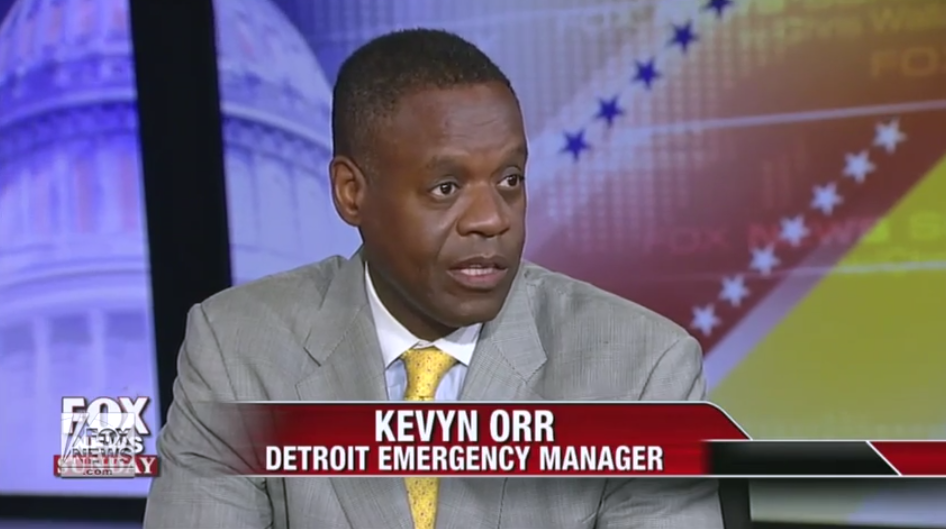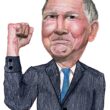(Kevyn Orr | Source: Fox News Sunday)
Detroit’s bankruptcy and a high profile lawsuit in San Jose highlight a nationwide effort led by fiscal conservatives to undo the basic promise embodied in public employee pensions—a guaranteed, defined retirement benefit. If they succeed in unraveling public pensions, as they have to retirement benefits offered by private companies, they might also be dismantling one of the most robust counter-cyclical measures that is keeping us from the brink of another crisis.
In Detroit, emergency manager Kevyn Orr is attempting to cut the pension obligations the city has promised to pay thousands of retirees. He argues that a pension is equivalent to bonded indebtedness, and that retirees should take a haircut so banks can recoup higher interest on their bonds. In San Jose, workers are battling the mayor in court over a ballot measure approved last fall that, if upheld, would circumvent collective bargaining and require public employees to make larger contributions to their retirement fund. Known as Measure B, the law would impose other unilateral changes to San Jose’s retirement plan, ultimately lowering the compensation of employees.
In numerous other states and cities, both liberal and conservative politicians and corporate-backed lobbies are attempting to roll back public pensions either by cutting existing obligations, as is the case in Detroit and San Jose, or by reducing future benefits for new hires.
| In numerous states and cities, both liberal and conservative politicians and corporate-backed lobbies are attempting to roll back public pensions. This effort could have devastating long-term impacts on the economy. Here’s why. |
This effort could have devastating long-term impacts on the economy. Here’s why.
One of the main causes of the financial crisis of 2008 was over-burdensome debt used to finance consumer spending. For decades, most Americans have seen the real value of their wages fall. But consumers didn’t cut back on buying cars, houses, electronics, and other goods. This is partly because the financial system proliferated complicated and risky securitized bonds and credit derivatives to expand the possible debt load on the bottom half of income earners.
The alphabet soup of securitized debt—CDOs, CMOs etc.—freed up hundreds of billions of dollars for the creation of new mortgages, credit cards, and other debt. Many of the loans extended through this laissez-faire regime of credit creation were predatory, designed to exploit low-income borrowers, but so long as the housing bubble continued to inflate, serious harm was contained. With millions of Americans still in command of purchasing power the economy chugged along, but it was an illusion of prosperity. The incomes of most consumers continued to plummet.
Indeed, the reduction of defined benefit pension coverage in the private sector is part of the overall decline in workers’ incomes over the past 30 years, a trend that has led to higher levels of consumer debt and less ability to sustain demand in the economy.
According to the Bureau of Labor Statistics, in the early 1990s, 35 percent of workers in the private sector were covered by a defined benefit pension system. This level was even higher in the 1970s. Today, the number of workers in the private sector with a defined benefit pension has dropped to just 18 percent. This translates into billions less in income for workers after they retire, meaning billions that are not injected into the economy in the form of consumer purchasing.
Massive levels of private debt and dwindling income to sustain this debt caught up with us in 2007. Combined with speculative gambles by the banks and insurance corporations, the system crashed. Many Americans cut back their spending and the crisis worsened.
The so-called recovery that has been underway since about early 2012 has seen prices of everything from corporate stocks to residential homes bounce back, but incomes for many Americans are not rebounding. The underlying structural cause of the economic crash hasn’t been addressed. Workers are still being paid at levels far below the level of previous decades while much of the national income pie is being devoured by the top 1 percent. Pension payments in the private sector continue to fall as new workers are offered only defined contribution plans, or in many cases nothing at all.
In Keynesian language, there is no force to sustain “aggregate demand.” Without consumer demand for basic goods, there won’t be industrial investment. Without investment there won’t be new jobs and increases in worker productivity, and the incomes of most Americans will continue to decline in real terms. The cycle spins downward without intervention to lift the majority into income security.
Consider what would happen now if the pension hawks were to dramatically scale back the retirement benefits that state and local governments have promised their employees. The crisis of declining incomes for the majority of Americans would dramatically worsen. Millions would endure real pay cuts and in turn reduce their household budgets, and the economic system would choke.
According to a Census survey of pensions, there are about 19.4 million Americans who are members of public employee retirement systems. About 8.6 million are currently drawing benefits from the 3,400 state and local pension funds of all 50 states, and thousands of counties and cities.
Each month these pension systems pump $60 billion into the U.S. economy in the form of retirement checks cut to their former employees, and also in the form of early withdrawals. These millions of pensioners spend the majority of this cash on consumer goods, healthcare, housing, food, and travel. It’s a total economic stimulus of almost three quarters of a trillion dollars a year.
The geographic distribution of U.S. public pension funds ensures that these dollars are circulated widely in every region of the nation. Retirees in California, New York, Texas, and Florida obviously expend enormous shares of the total flow of pension income. There are over a million retired California public employees collecting and spending their pensions today, but even tiny Wyoming counts 22,000 pensioners on its rolls. As Katherine Sciacchitano notes, “far from just supporting retirees, defined-benefit pensions contribute to economic recovery by providing a long-term, stable source of counter-cyclical spending—spending that continues even during economic downturns.”
Public employee pensions are a key source of income for millions of middle-class Americans who sustain a big slice of the U.S. economy simply by spending their retirement checks. If pension hawks are successful in Detroit, San Jose, and elsewhere, if the attack on pensions translates into a successful dismantling of this part of the American social contract, then it’s likely that the share of income flowing to the bottom 90 percent of the nation would collapse even further.
Over the long-term, and combined with other causes of income inequality, it would mean economic stagnation, and perhaps even lead to a deflationary spiral.
Darwin Bondgraham is a sociologist and journalist who writes about political economy. His writing has appeared in Counterpunch, Truthout, Z Magazine and others. Follow him @DarwinBondGraham.






0 Comments